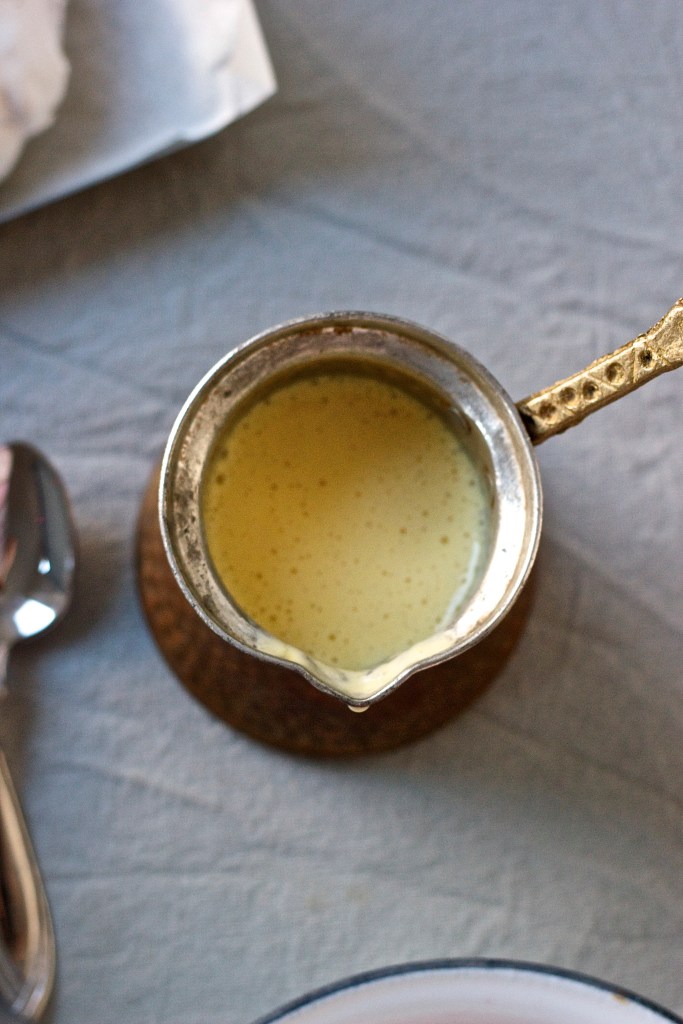
Unsurprisingly, over the course of the past year, my boyfriend and I have been watching a lot of Netflix, HBO, Youtube etc. Including, of course, a lot of cooking shows – at times we were quite literally “Binging with Babish”! The other day we were following Alex (the guy behind “French guy cooking”) as he was (first researching and then) cooking his way through French mother sauces.
If you are somewhat familiar with French cooking you may have already come across the concept of “mother sauces” (sauces mères). A term most often attributed to chef Auguste Escoffier, it is used to describe a number of different sauces, including bechamel sauce, sauce espagnole, tomato sauce, veloute sauce and hollandaise sauce (the latter’ inclusion is somewhat controversial and some argue the fifth mother sauce is actually mayonnaise), which form the building blocks of other sauces and hence a large range of different types of French dishes.
And suddenly it hit me – custard is nothing other than the mother sauce of dessert!
Now, when I talk about custard in this context, what I am referring to is a mixture of some kind of sweetened dairy, typically milk or cream (or a mix of both) that’s been thickened with eggs (or egg yolks). While some recipes also call for small quantities of starch in the form of flour, corn or potato starch, some will argue this technically turns a custard into a pastry cream.
Even the basic custard (or pastry cream) formula can have vastly different results. Once you start playing with the ratio of ingredients and the cooking technique you can end up with anything from a thin pouring custard (also referred to as a creme anglaise) to the type of soft set custard you might be familiar with from eating clafoutis or even the type of baked custard sturdy enough to be cut into large chunks to eat with your hands like prune-studded Far Breton. And once you start playing around with different types of dairy you get even more variations on the basic theme – after all, what is a cheesecake if not a baked custard made with cream cheese or ricotta instead of milk or cream?
You may be thinking that this is where the analogy with French mother sauces breaks down, because custard as a basic concept comes in so many different guises already. But what makes custard essentially a mother sauce of dessert is the fact that it also forms the basis of so many other creams (and thus different desserts). A simple custard thickened with both eggs and starch can be easily transformed into a number of different creamy fillings – the addition of butter turns it into creme mousseline (and what is used to fill Paris Brest), loosening the pastry cream with whipped cream (and gelatine) produces creme diplomate and the addition of meringue turns it into creme chiboust – a filling often used for choux buns and saint honore, to name just a few examples.
Whether or not the analogy with French mother sauces stands up to scrutiny, when it comes to desserts, making custard is a good basic technique to master, and as key kitchen skills go, not a difficult one either.
A good place to start is creme anglaise, both because it is easy enough to get right and a great thing to have in the fridge – to pour over a bowl of berries, a slice of fresh apple pie or even to stir into some rice pudding to make it extra creamy and luxurious. And while creme anglaise is commonly made with vanilla bean and sugar, it is delicious flavoured in other ways, e.g. with cardamom (which would be amazing with a plum crumble) or tonka bean (maybe with a sourcherry pie?) and even honey and saffron (beautiful with apricots and pistachios). So once you have mastered the basic recipe, experiment with what you have at home and your favourite flavour combinations!
Creme Anglaise
Ingredients
500ml milk
1 vanilla bean
4 egg yolks
50g sugar (or more to taste)
Directions
Split the vanilla bean down the middle and scrape out the seeds with a sharp knife. Add both to a medium sized saucepan together with the milk. Heat the milk until the milk starts to steam. Meanwhile, whisk the eggs and sugar in a separate bowl until pale and frothy.
Once the milk is steaming, remove the vanilla bean* and pour ⅓ of the steaming milk over the egg yolks while whisking to temper the yolks. Then pour this mixture back into the saucepan. Whisking continuously, continue cooking the Creme Anglaise on a low heat until it coats the back of a spoon.
Serve hot or cold.
*Do not throw away the vanilla bean – rinse it well under hot water and set aside to dry for a few days. Once fully dry, place in a jar of plain sugar – over time the sugar will absorb the aroma from the vanilla bean and, hey presto, you have homemade vanilla sugar!
